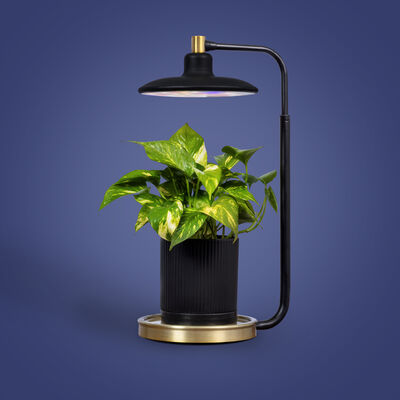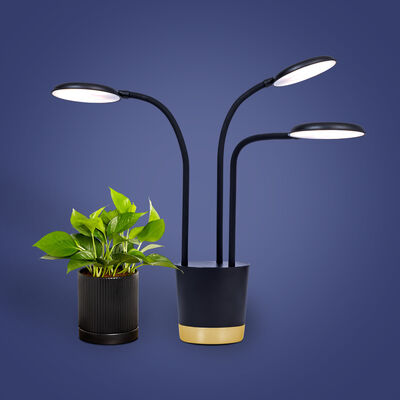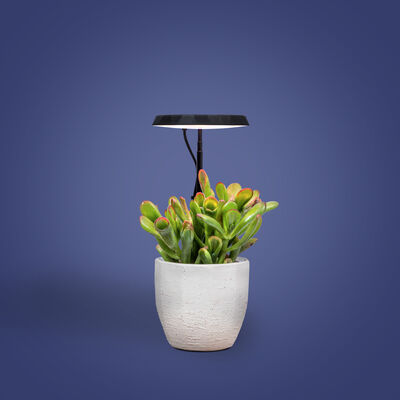
Let There Be (Optimal) Light
Your indoor plants will thrive when lit under the best conditions.
The right lighting can turn your interior design from drab to cheery. It can even change the way you feel within a certain space (mood lighting, anyone?). But how do indoor plants respond to your home's lighting? Well, just as the right lighting can leave you feeling cool, yet radiant, your indoor plants will thrive when lit under the best conditions.
The Spectrum of Light: Types of Indoor Lighting
Light is light, right? Not exactly. Plants are highly sensitive to lighting conditions and require specific amounts in order to absorb sunlight, water, and carbon dioxide, and transform them into oxygen and glucose—AKA, photosynthesis. Nerdy as it sounds, when our plants photosynthesize we reap the benefits: The process is what creates an oxygen-rich environment within our plant-filled homes. So it's really important to understand your plant's needs and how to give it to them.
Low Light
Sometimes you have to work with what you've got. If your home has soft lighting, you'll need plants that can withstand slightly dim conditions. While all plants need some natural light to survive, there are plants that can tolerate low light, such as pothos, ZZ, and snake plants. Just remember that since plants photosynthesize less in low lighting, you may need to adjust your watering schedule to match.
Medium Light
Medium light is less intense than bright light, but provides more than low light. You may have bright light near a window, but medium light a bit further into a room. Many plants appreciate this moderate type of lighting.
Bright Light
Does your space receive lots of light? A light-soaked space can be great for plants, but it depends on the intensity of the light. You'll need to consider whether your bright light is direct or indirect.
Direct Light
Direct light is unfiltered, meaning your plants are hit directly by sunbeams. This may result in a light that's too intense for many indoor plants, causing leaf burn. The best plants that can tolerate this type of light are succulents and cacti. Think jade, echeveria, and a string of pearls.
Indirect Light
Bright indirect light is ideal for plant growth. It provides ample light for photosynthesis but doesn't risk singeing your plant's leaves.
Too Much vs Too Little
How can you tell if your plant is getting the right lighting? Plants will show you when they're over or under exposed to light.
Signs Your Plant Is Getting Too Much Light
- Brown patches on leaves
- Singed leaf tips
- Leaf loss
Signs Your Plant Is Getting Too Little Light
- Stunted growth
- Stems that are elongated, as if reaching for more light
- Leaf loss
- Loss of color, leaves appear less vibrant
Too Much vs Too Little
How can you tell if your plant is getting the right lighting? Plants will show you when they’re over or under exposed to light.
Signs Your Plant Is Getting Too Much Light
- Brown patches on leaves
- Singed leaf tips
- Leaf loss
Signs Your Plant Is Getting Too Little Light
- Stunted growth
- Stems that are elongated, as if reaching for more light
- Leaf loss
- Loss of color, leaves appear less vibrant

Calculate the Best Lighting
Does getting optimal lighting for indoor plants require complicated choreography? A little to the left. No wait, it's wilting. Back to the right, but not that far right! While achieving the perfect lighting may take a couple adjustments, there are a few key tips that can help you to avoid the awkward light dance.
Tip #1: Look to the Light
If there's an area where you're considering setting your plant, take note of how much light it receives in the morning, afternoon, and during golden hour. How intense is that light? Is it direct or indirect? Knowing these things will allow you to understand how well your plant can adjust to the space before you even move it.
Tip #2: Get to Know Your Plant
Formal introductions aren't necessary, but learning a little background knowledge about your plant's likes and dislikes will improve your relationship. Are they a light lover, or more of a partial shade, filtered light type of plant? Make sure to research their preferences so you can better match them within your space. This is also how you can anticipate your plant's changes depending on the light they're receiving. For example, the pattern on a pothos plant may become more or less variegated based on the amount of light hitting its leaves.
Tip #3: Understand Your Space
Even if you're not great with directions, it's worth breaking out the compass to know which way your windows face. This helps you to understand the type of light your rooms receive based on how the sun moves through the sky.
West-Facing Windows: As the sun begins to set in the west, plants in west-facing windows will receive bright direct light. Since you'll get ample lighting from mid to late afternoon, west-facing windows are well suited to sun-loving plants.
South-Facing Windows: Plants near south-facing windows will soak up the most direct sunlight. Since these windows get ample lighting that may be too intense for some plants, stick with those that can tolerate bright direct light.
East-Facing Windows: Plants near east-facing windows will enjoy morning light as the sun rises but will have only indirect light as it moves west in the sky.
North-Facing Windows: Time to grab your low-light tolerant plants. North-facing windows don't receive any direct light, but they will provide enough indirect light for plants that don't require much to survive.


